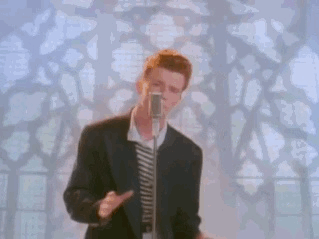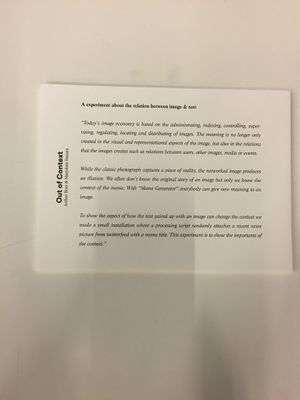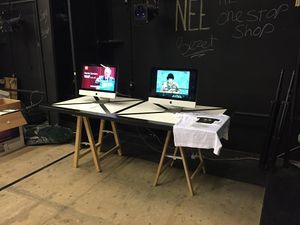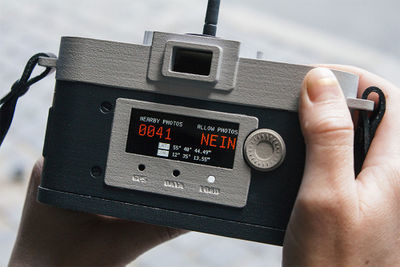Difference between revisions of "User:Arthur Vince/UTC"
Arthur Vince (talk | contribs) |
Arthur Vince (talk | contribs) |
||
| Line 134: | Line 134: | ||
==Exploration== | ==Exploration== | ||
| + | [[File:markthal_exploration1.jpg|400px]] | ||
| + | [[File:markthal_exploration.jpg|400px]] | ||
==Research== | ==Research== | ||
Revision as of 10:17, 29 September 2015
UNRAVEL THE MEME
RICKROLLED
In 1987 Rick Astley was released, making it a solo debut single of the album 'Whenever You Need Somebody'. Later at the 4CHAN community, one of the founders m00t, says that the RickRolling started on the VideoGame board circa May 2007. This all started with the predecessor named 'DuckRoll'. The Duckroll all started because a word filter on the 4CHAN boards turned the word "egg" into "duck". When typing eggroll it would turn into duckroll. Later a picture with a duck on wheels became popular "Duckroll" by send it to a friend or someone who is anticipating something and gets this picture to trick them. Basically getting a duckroll when instead they want to see another picture.
Since the game GTA IV was so anticipated int he year 2007 people started to link Rick Astley's video on the 4CHAN platform disguising it as a sneak preview or trailer for the anticipated game. This is how the RickRoll all started. It is a 'Bait and Switch' type of joke.
This can happen on Youtube itself, with misleadingly titled videos, or with links from other sites to youtube. These videos usually have a misleading image in the middle of the video, so that the thumbnail on youtube looks legit. Sometime they even make names that seem legit.
Timeline
- 2007 (APRIL/MAY): 4CHAN, DuckRoll.
- 2008: Gaming Scene, GTA IV Sneak Peak Release video is Rick Astley’s music video
- 2008: Youtube uses it as April Fools Joke.
- 2008: NYC Mets uses “Never going to give you up” as 8th inning song, because of popular vote of the people
- 2008: Rick Astley gets to preform his classic song on the Macy's Thanksgiving Parade after 14 years.
- 2008: Rick’s song becomes so popular that he even gets voted for “Best Act Ever” in the MTV European Music Awards.
- 2008: Studies show that in 2008 18 million adult Americans were RickRolled.
- 2010: Lyrics are used by Oregon’s house of Representatives during a House Sessions.
- 2010: WikiLeaks uses lyrics in an article about serious attacks on Visa, MasterCard, Amazon and Paypal
- 2011: The Whitehouse tweets a link, which is actually a link to Rick Astley’s music video.
Popularity
The reason why it became so popular was because it was a way to be part of the joke. The Rickrolling slowly expanded from the Gaming-Scene to more of the mainstream where other anticipated audiences were tricked too. It is also fun to see your friends or known people react to it as a form of Peer-Reaction. This type of jokes have been tormenting the internet from a long time, with not only having the RickRolled as a Bait-and-Switch video there are also others in that same category such as:
- Scary Prank Videos
- Two Girls one Cup
(Don't google for your own safety) - "X Amount of girls online in your neighborhood and want to chat" - Ads
- Fake Close Buttons on Ads
- Fake Outs
Targets
- People Looking for Movie / Game Trailers / Footage
- Abridged Series Watchers
- People who try to watch TV on Youtube
MORE RESEARCH
Which News Sites
Generating Content
For the generation of the twitter content we will probably have to use an API to get our content.
Types of APIs - Source - There are many different types of APIs for operating systems, applications or for websites. Windows, for example, has many API sets that are used by system hardware and applications — when you copy and paste text from one application to another, it is the API that allows that to work. Most operating environments, such as MS-Windows, provide an API so that programmers can write applications consistent with the operating environment. Today, APIs are also specified by websites. For example, Amazon or eBay APIs allow developers to use the existing retail infrastructure to create specialized web stores. Third-party software developers also use Web APIs to create software solutions for end-users.
Popular API Examples - Source -
Programmable Web, a site that tracks more than 13,000 APIs, lists Google Maps, Twitter, YouTube, Flickr and Amazon Product Advertising as some of the the most popular APIs. The following list contains several examples of popular APIs:
- Google Maps API: Google Maps APIs lets developers embed Google Maps on webpages using a JavaScript or Flash interface. The Google Maps API is designed to work on mobile devices and desktop browsers.
- YouTube APIs: YouTube API: Google's APIs lets developers integrate YouTube videos and functionality into websites or applications. YouTube APIs include the YouTube Analytics API, YouTube Data API, YouTube Live Streaming API, YouTube Player APIs and others.
- Flickr API: The Flickr API is used by developers to access the Flick photo sharing community data. The Flickr API consists of a set of callable methods, and some API endpoints.
- Twitter APIs: Twitter offers two APIs. The REST API allows developers to access core Twitter data and the Search API provides methods for developers to interact with Twitter Search and trends data.
- Amazon Product Advertising API: Amazon's Product Advertising API gives developers access to Amazon's product selection and discovery functionality to advertise Amazon products to monetize a website.
Useful Links
Popular Memes
These memes below are a few of the most popular memes we will be using as a substitute text to change the context of the images. By using these titles hopefully this was create an interaction or topic of conversation.
GOODGUY GREG • FOREVER ALONE • YOU DON'T SAY... • NOT BAD! • THEREFORE... ALIENS!! • BAD LUCK BRIAN • WAT? • MOON MOON • DRINKING MY OWN PISS • HOMOPHOBIC SEAL • FIRST WORLD PROBLEM • SCUMBAG STEVE • BRONIES • WOW • FRIENDSHIP IS MAGIC • BITCH PLEASE • WATCH OUT, WE HAVE A BADASS OVER HERE. • OVERLY ATTACHED GIRLFRIEND • I TOOK AN ARROW TO THE KNEE • RIDICULOUSLY PHOTOGENIC GUY • SEE ME ROLLIN', THEY HATIN' • DERP • ONE DOES NOT SIMPLY WALK INTO MORDOR • HATERS GONNA HATE • DO YOU EVEN LIFT, BRO? • SOCIALLY AWKWARD PENGUIN • SERIOUSLY? • TRUE STORY • DEAL WITH IT • AIN'T NOBODY GOT TIME FOR THAT • I THANK NOT ONLY GOD BUT ALSO JESUS • U MAD? • LOOK AT ALL THE FUCKS I GiVE I DON'T WANT TO LIVE ON THIS PLANET ANYMORE • 2/10 WOULD NOT BANG • I LIED • OH GOD... WHY • HONEY BADGER DON'T CARE • COME AT ME BRO • MY BODY IS READY • WORK-SAFE PORN • THAT ESCALATED QUICKLY • MOTHER OF GOD • SHUT UP AND TAKE MY MONEY • LIKE A BOSS • IT'S A TRAP! • RUINED CHILDHOOD • CLOSE ENOUGH • DEAL WITH IT!
CONCEPT
Since the over all theme is "CONTEXT" we had two types of contexts that we are incorporating. We want to show that by changing the text of an image it can create a new context of the image. The story behind it will change and it might even change the topic conversation because of his certain image. The other part is the context of "RickRolling" it all started with substituting a link with other content.
TECHNICALITIES
By taking news pictures from a twitter feed we get a reliable source of content and data. All the data is gathered by the processing script and from a text file a
DOWNLOADS
Down below are downloadable links, mainly our presentations.
- Pitch Presentation: Out of Context
- PDE Script: Online + Data Pictures
- PDE Script: Offline + Java Library
END RESULTS
On Thursday we had our first presentation at Eendrachtstraat.
UNRAVEL THE INFRA-ORDINARY
Assignment
Design/make/craft one or more objects, spaces (or both) that address changes in physical and/or social behaviour in public and private space due to digital devices. The final design must be based on findings from your initial research and should relate to a clearly articulated perspective. Examples of possible perspectives are: critical, speculative, practical, visionary or other.
You will be working in duos. Each duo must post their research on the wiki.
Medium, technology and material choices are open. However you must be able to make clear how the choices made are relevant to your aims and outcome.
Topics digital influence
- Sifi, voice recognition
- QR code
- Social Media
- Payments without code
- Virtual Life
- Games and rewarding
- reading news
- vinger print
- google glass
- Pokemon Go
- Posture and body movement change
- The Phone/internet as a space vs the physical world
- Looking down, save with phone
Exploration
Research
EVERY TIME THERE’S a sunset worth seeing in New York City, my Instagram feed is awash in shades of orange, pink, and purple. I’m not complaining—not really. Sunsets are pretty! And I, too, am guilty of a sunsetgram or two. Or 10. But after seeing the 15th photo of downtown Manhattan backlit by a glowing sky, it starts to get a little … I don’t know. Tired.
Those of us guilty of this invariably apologize by writing self-deprecating captions and funny hashtags. But someone, or something, really ought to keep us from taking such clichéd pics to begin with. That’s the idea behind Philipp Schmitt’s Camera Restrica.
The German designer has developed a camera that allows the user to take only original photos. Want to snap a pic of the Eiffel Tower? Good luck, because it’s not gonna happen. But that gas station next to the Dairy Queen in Grand Island, Nebraska, is fair game.
Schmitt’s camera (it’s a prototype at the moment and doesn’t take actual photos just yet—he’s working on integrating sensors and optics), houses a smartphone that uses GPS metadata from Flickr and Panoramio to determine how popular a location is. If it identifies more than 35 photos taken in a given location—about 115 feet in any direction from where you’re standing—the camera’s shutter retracts and blocks the viewfinder so you can’t take a photo. A display on the camera indicates how many photos have been taken in that location, and an audible cue reminds you to move along.
Camera Restricta from Philipp Schmitt on Vimeo.
That a piece of technology can judge creativity on something as quantitative as geo-tags is both fascinating and discomforting. “A lot of people are really offended by the idea,” Schmidt says. There are some inherent flaws in the logic, which he readily cops to. A single GPS point doesn’t take into account that the ugliest bench known to man may be located just across the street from the Eiffel Tower, and may not recognize that is what you’re trying to photograph.
Still, it’s interesting to consider how something like Camera Restrica could be integrated into existing technology. There are valid worries of censorship—that a government might be able to dictate what you can and can’t photograph. But mostly, I find the concept funny. I’d like to see it taken even further, so that a camera’s viewfinder uses image recognition software to determine if what you’re looking at, not just where you are, is a worthwhile photo. It could take into account different parameters—time of day, season, how many people have take similar photos on Instagram—and then tell you that maybe that photo of your feet in the sand on a beach isn’t such a good idea after all.
http://philippschmitt.com/projects/camera-restricta
Concept Idea
i went doing field research and i found out, same as in asia that everybody makes pictures in the same places. So i want to the markthal and saw that everybody was making pictures of the building outside, of the food, and the ugly artwork on the sealing. So I was thinking. why do people make these pictures. There are already thousand of pictures who are the same or even better. why do people need there own pictures and most of these pictures they just keep in there phones or cameras. Some people were filming while walking. So i was thinking can i reconstruct the markthal with these pictures by overlaying them. So you could see the density of the places people photographed the most. For instants the ugly artwork if i use all the pictues already only under the #markthal you get 27.000 pictures. If i overlay these pictures you can see wich points are more photographed than other places. And I was thinking can i make a user based sort of streetview virtuality with these pictures. So people dont make these pictures for nothing but join forces and reconstruct the physical world in a virtuality
Because than we can slowly reconstruct the world in our virtual world and live or lives more save because we dont need to go somewhere anymore and we dont allow google with street view to control our lives. We can take our dangerous worlds to a much more saver virtuality where in we create and shape our own markthal with the focus on the points we find the most interesting (based on the density of the photographs) so we dont have to see everything only what is really important.
Questions:
- Why do we all want our own picture of the markthal?
- What are we doing with the pictures?
- Where is the density of pictures the highest?






